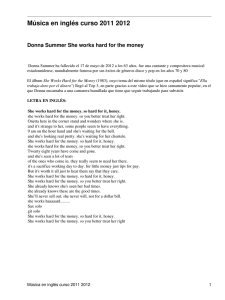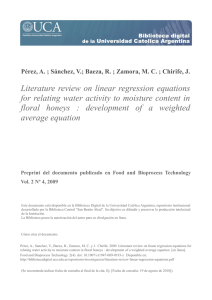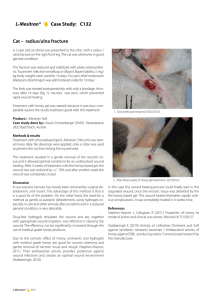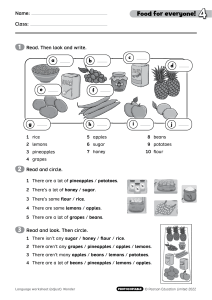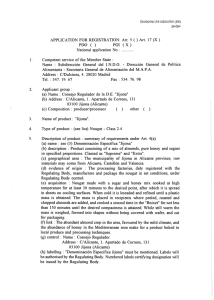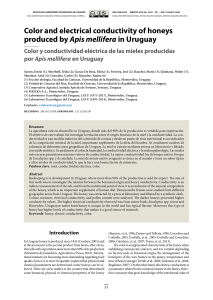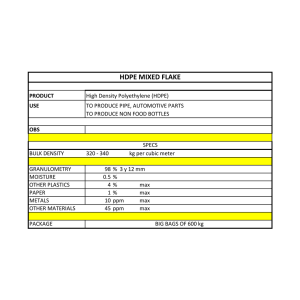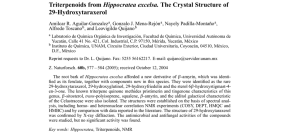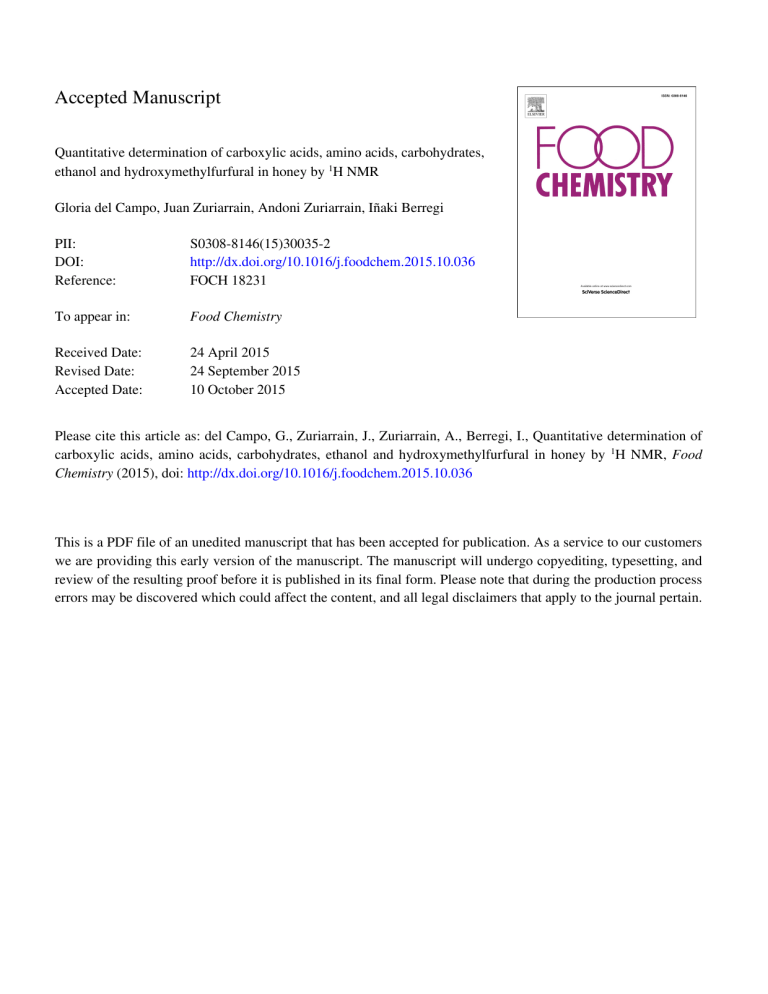
Accepted Manuscript
Quantitative determination of carboxylic acids, amino acids, carbohydrates,
ethanol and hydroxymethylfurfural in honey by 1H NMR
Gloria del Campo, Juan Zuriarrain, Andoni Zuriarrain, Iñaki Berregi
PII:
DOI:
Reference:
S0308-8146(15)30035-2
http://dx.doi.org/10.1016/j.foodchem.2015.10.036
FOCH 18231
To appear in:
Food Chemistry
Received Date:
Revised Date:
Accepted Date:
24 April 2015
24 September 2015
10 October 2015
Please cite this article as: del Campo, G., Zuriarrain, J., Zuriarrain, A., Berregi, I., Quantitative determination of
carboxylic acids, amino acids, carbohydrates, ethanol and hydroxymethylfurfural in honey by 1H NMR, Food
Chemistry (2015), doi: http://dx.doi.org/10.1016/j.foodchem.2015.10.036
This is a PDF file of an unedited manuscript that has been accepted for publication. As a service to our customers
we are providing this early version of the manuscript. The manuscript will undergo copyediting, typesetting, and
review of the resulting proof before it is published in its final form. Please note that during the production process
errors may be discovered which could affect the content, and all legal disclaimers that apply to the journal pertain.
Quantitative determination of carboxylic acids, amino acids,
carbohydrates, ethanol and hydroxymethylfurfural in honey by
1
H NMR
Gloria del Campo, Juan Zuriarrain, Andoni Zuriarrain, Iñaki Berregi*
University of the Basque Country EHU/UPV, Faculty of Chemistry
Manuel Lardizabal 3, 20018 Donostia-San Sebastián, Gipuzkoa, Spain
ABSTRACT
A method using 1H NMR spectroscopy has been developed to quantify simultaneously
thirteen analytes in honeys without previous separation or pre-concentration steps. The
method has been successfully applied to determine carboxylic acids (acetic, formic, lactic,
malic and succinic acids), amino acids (alanine, phenylalanine, proline and tyrosine),
carbohydrates (α- and β-glucose and fructose), ethanol and hydroxymethylfurfural in
eucalyptus,
heather,
lavender,
orange
blossom,
thyme
and
rosemary
honeys.
Quantification was performed by using the area of the signal of each analyte in the honey
spectra, together with external standards. The regression analysis of the signal area
against concentration plots, used for the calibration of each analyte, indicates a good
linearity over the concentration ranges found in honeys, with correlation coefficients
higher than 0.985 for the thirteen quantified analytes. The recovery studies give values
over the 93.7–105.4% range with relative standard deviations lower than 7.4%. Good
precision, with relative standard deviations over the range of 0.78–5.21% is obtained.
Keywords: 1H NMR; Honey; Metabolites; Quantitative analysis
*
Corresponding author.
Tel.: +34 943 018210
Fax: +34 943 015270
E-mail address: [email protected]
1
1. Introduction
Honey is a natural syrup which sensory properties (color, flavor and texture) are a
complex function of physicochemical parameters, mainly determined by the botanic and
geographic origins. In essence, it is a concentrated aqueous solution of glucose (31%)
and fructose (39%), but other species account for, on average, 13% (w/w) of the
sample. Honey contains free amino acids at a level of 1% (w/w), pollen being one of
their sources. Proline, which might originate from bees, is the prevalent amino acid and
makes up 50–85% of the amino acid fraction (White, 1975). Organic acids are present in
honey at low concentrations (<0.5%) and they are related to color, flavor and physicalchemical properties of the honey, such as pH, acidity, and electrical conductivity. Organic
acids, chelate metals and so forth can synergistically enhance the antioxidant action of
phenolic compounds (Gheldof, Wang & Engeseth, 2002). Moreover, acetic acid and
ethanol can be used as fermentation indicators and formic acid as an indicator for the
treatment of Varroa infestation (Calderone, 2000).
Traditionally, the analysis of minor organic compounds of the honey is carried out by
means of chromatographic methods. The amino acid composition of honey has received
considerable attention and has proven to be a good indicator when characterizing its
geographic or botanical origin. In amino acids determination, mainly chromatographic
techniques were applied. The results obtained using gas chromatography (GC) showed
that differences between geographic origins (Gilbert, Shepherd, Wallwork & Harris, 1981)
or botanical varieties existed (Pirini, Conte, Francioso & Lercker, 1992). This technique is
limited by the necessity of derivatizing the compounds. Determination of amino acids in
honey by high-performance liquid chromatography (HPLC) also shows a problem caused
by the high sugar concentration and the presence of other chemical species which would
poison HPLC columns (Gilbert et al., 1981; Pirini et al., 1992; Nozal, Bernal, Toribio,
Diego & Ruiz, 2004; Hermosín, Chicón & Cabezudo, 2003). Analytical methods for
determination of organic acids in honey have been reviewed (Mato, Huidobro, SimalLozano & Sancho, 2006a) and enzymatic, chromatographic and electrophoretic methods
2
have been used for quantifying purposes. The aldehyde 5-hydroxymethylfurfural (HMF) is
considered an important quality parameter for honey, because elevated concentrations
provide an indication of overheating, storage in poor conditions or aging of the honey.
The International Honey Commission recommends three methods for the determination
of HMF: two spectrophotometric methods and a HPLC method. These three methods have
been compared and the HPLC method seems to be the most appropriate because the
presence of compounds which interfere with the UV methods is overcome (Zappalà,
Fallico, Arena & Verzera, 2005). GC and HPLC procedures have usually been applied for
analyzing carbohydrates in honey (Mateo, Bosch, Pastor & Jiménez, 1987; Swallow &
Low, 1990; Nozal, Bernal, Toribio, Álamo, Diego & Tapia, 2005), where HPLC methods
are the most widely used given that derivatization is not normally necessary.
Quantitative methods in nuclear magnetic resonance (NMR) spectroscopy have been
successfully used. Since NMR spectra contains the resonances of all components with
concentrations higher than the detection threshold (around 5-10 µM), they can be
advantageously utilized for quantitative analysis if certain technical and instrumental
parameters are taken into account; furthermore, in order to obtain accurate quantitative
results the signals could be free of overlapping and correctly integrated (Saito et al.,
2004; Pauli, Jaki & Lankin, 2005; Pauli, Jaki & Lankin, 2007). As has been proved in
various natural products, 1H NMR spectroscopy gives a good overall picture of all types of
organic compounds in the sample. Most published methods use internal standards (Pauli
et al., 2005), although there are applications where external standards have been
employed (Burton, Quilliam & Walter, 2005; López-Rituerto, Cabredo, López, Avenoza,
Busto & Peregrina, 2009).
In recent years, the use of high-resolution NMR techniques in the study of the honey
has attracted the interest of a number of groups and, as result, 1-dimensional and 2dimensional NMR experiments have been explored in order to characterize and to classify
a great amount of honeys. High-resolution NMR spectroscopy coupled with multivariate
data analysis has been applied to analyze metabolite profiles, to detect variations in the
composition of honeys, to find biomarkers and to clearly explain the molecular structure
3
of the most successful compounds that differentiate honeys (Lolli, Bertelli, Plessi,
Sabatini & Restani, 2008; Consonni & Cagliani, 2008; Beretta, Caneva, Regazzoni,
Bakhtyari & Facino, 2008; Donarski, Jones & Charlton, 2008; Donarski, Jones, Harrison,
Driffield & Charlton, 2010). Quantitative analysis has also been attempted. Sandusky and
Raftery (2005) used selective TOCSY NMR experiments to obtain relative concentrations
for five amino acids and ethanol in honey. Its study pointed out the problems showed for
this type of sample; one was caused by the very large difference in concentrations
between the major components and minor components, and another due to the
unfortunate effects of the sugars on the viscosity and NMR relaxation properties. At
higher honey concentrations, significant reduction in sensitivity of some amino acids was
observed, this being attributed to the higher viscosity of the honey samples and
consequent increase in the relaxation rate during the TOCSY spin lock used.
The objective of the present study was to develop an experimental procedure based
on 1H NMR spectroscopy to quantified metabolites in honey which would allow for the
best resolution of the signals, an accurate quantification and a reduced time of analysis.
This method allows for the simultaneous quantification of carboxylic acids (acetic, formic,
lactic, malic and succinic acids), amino acids (alanine, phenylalanine, proline and
tyrosine), sugars (fructose and α- and β-glucose), ethanol and 5-hydroxymethylfurfural,
in honey; in total, thirteen analytes.
2. Materials and methods
2.1. Reagents
The chemical reagents, all of analytical grade, were purchased from Sigma-Aldrich,
with the exception of 1,3,5-benzenetricarboxilic acid, formic acid and hydrochloric acid,
which were purchased from Merck, and ethanol, which was purchased from Panreac. All
solutions were prepared with double-distilled water (from this point on, “water”).
4
2.2. Honey samples
The honeys analyzed were of Spanish origin and they were purchased from local
markets. The total sugar percentage of each honey was previously measured by
refractometry as sucrose w/w percentage. Next, 20.0 g of honey were weighed and
mixed with 15 mL of water. The pH of the resulting solution was adjusted to 1.0 by
adding HCl 1.2 M from an automatic titrator, provided by a combined pH electrode. The
total sugar percentage was then reduced to a final value of 40.0%, w/w, by dilution with
acidified water at pH 1.0. The total sugar percentage of pure honeys is in average ~80%,
w/w (Ball, 2007; Bogdanov, Jurendic, Sieber & Gallmann, 2008), but is different from
one honey to another, so each honey needed a different dilution. Finally, the solution
obtained was filtered through 0.45 µm nylon membrane (Cameo, Scharlab, Barcelona,
Spain), and its 1H NMR spectrum was recorded in triplicate by the method explained
further on. The concentration of the thirteen analytes was calculated from the 1H NMR
spectra by using the absolute area of their respective signals and the calibration
equations.
2.3. Standard solutions
Nine different standard solutions containing the principal compounds of the honey
were prepared to approach natural matrices as much as possible. The chosen
concentrations ranged from the values experimentally found for three types of
representative honeys: eucalyptus, rosemary and thyme (Table 1) (Hermosín et al.,
2003; Nozal, Bernal, Diego, Gómez & Higes, 2003; Nozal et al., 2004; Zappalà et al.,
2005; de la Fuente, Ruiz-Matute, Valencia-Barrera, Sanz & Martínez-Castro, 2011).
These standard solutions contained 29 organic compounds, which signals appear in the
1
H NMR spectra, and potassium, added to adjust the ionic strength of the samples to a
constant value of 1.0 g per kg honey, minimum observed in honeys (Bogdanov et al.
2008). The pH was adjusted to 1.0 and the total sugar percentage to 40%, w/w, applying
the procedure described for honey samples. The spectra of the standard solutions were
recorded and the selected peak areas for each analyte were measured by electronic
5
integration of expanded regions around selected resonances. The integrals taken from
the spectra were not subsequently normalized and the areas of the corresponding signals
were calculated as absolute integrals. Calibration graphs were obtained by plotting the
selected peak areas for each analyte against its concentration.
2.4. 1H NMR spectroscopy
600 µL of the sample (standard solution or pre-treated honey sample) were placed
into a 5 mm outer diameter NMR tube, with 100 µL of a solution containing 70% (v/v)
D2O, 10.0 g L–1 of sodium 3-trimethylsilyl-3,3,2,2-tetradeuteriopropionate (TSP) and 1.0
g L–1 of 1,3,5-benzenetricarboxilic acid (BTC). The final concentrations were 10% D2O,
1.43 g L–1 of TSP and 0.14 g L–1 of BTC. BTC was added as an internal standard which
supplied a reference peak for the phenolic region (5.8–9.5 ppm) (Berregi, del Campo,
Caracena & Miranda, 2007). One-dimensional spectra was recorded on a Bruker Avance500 MHz spectrometer (Karlsruhe, Germany). To obtain the spectra of the samples, 128
scans of 64 K data points were acquired at 30ºC using a spectral width of 8012 Hz (16
ppm), acquisition time of 4.0 s, recycle delay of 2.0 s and a 90º flip angle, requiring
about 13 min per sample. Water suppression was achieved by using the one-dimensional
nuclear Overhauser effect spectroscopy (1D NOESY) pulse sequence, incorporating presaturation during the relaxation delay and mixing time (150 ms) (McKay, 2011) and the
pre-saturation power used was the minimum needed to effect complete suppression of
the water peak. The receiver gain setting for a given pulse sequence was adjusted
manually in preliminary experiments and it was held constant for all the spectra. The
Free Induction Decay signals were processed before Fourier transformation using Bruker
software, TOPSPIN 1.3. A broad-line of 1.0 Hz was applied to obtain a good sensitivity
(i.e. signal/noise) and sufficient resolution (line width). The spectra were referenced to
the TSP singlet peak at 0.0 ppm. To attain reliable results the phasing and the baseline
correction over the entire spectral range are critical, so these processes were carried out
manually, as we did in a previous work (del Campo, Berregi, Caracena & Santos, 2006).
6
In all instances, the baseline was additionally corrected over the integrated regions.
Integral values were entered into Microsoft Excel spreadsheets for further processing.
2.5. Method validation
The proposed method was validated in terms of linearity, limits of detection and
quantification, analytical recovery as well as precision and accuracy. The linearity was
tested by regression analysis of the absolute integrals of the peaks of the analytes, with
respect to their corresponding concentrations in the nine standard solutions.
Recovery was tested through the standard addition procedure on two different types
of honeys: eucalyptus and rosemary. The procedure used here was practically the same
as that described in section 2.2. for honey samples. For each honey, 10.0 g were
weighed and mixed with 5 mL of standard solution “9” and 10 mL of water, another
10.0 g with 10 mL of the standard and 5 mL of water, and another 10.0 g with 15 mL of
the standard. From this point on, the method was identical as section 2.2. For each
addition, one spectral acquisition was made with three repetitions of the data processing
per spectrum, in total, 9 measurements. By using the selected peak areas for each
analyte and the calibration graphs, the content of the thirteen analytes was calculated in
the original and in the enriched honeys, as well as the recovery and its absolute (SD) and
relative (RSD, %) standard deviation.
Accuracy
and
precision
of
the
method
were
determined
through
repeatable
measurements, by analyzing three different preparations of the same standard solution,
with three repetitions of the data processing per spectrum (in total, 9 measurements). By
using the selected peak areas for each analyte and the calibration graphs, the content of
the thirteen analytes was measured. The accuracy was determined as the bias for each
analyte in the standard solution, which was calculated as measured content — nominal
content x 100/nominal content. The precision was determined as the RSD of each
analyte content.
7
3. Results and discussion
3.1. 1H NMR spectra of honey samples
The assignment of the signals identified in our honeys is reported in Table 2. All of
these assignments were confirmed by recording the NMR spectra of the individual
compounds and by comparison with chemical shift values in the literature. Moreover, we
recorded the spectra of the nine standard solutions containing sugars, amino acids, acids
and alcohols in proportions close to their natural concentrations in honey (Table 1). The
detected peaks and the variation of their areas according to variation of their
concentrations allowed the confirmation of previously assigned peaks.
Fig. 1 shows the 1H NMR spectra of a sample of lavender honey, divided in three
regions. The other honeys present qualitatively similar spectra. Regarding the low
chemical shift region in Fig. 1A (0.8–3.1 ppm), the major signals correspond to amino
acid proline according to its relatively high concentration in honey. Multiplets at 2.05 and
2.17 ppm were assigned to H2 of proline, whereas the multiplet at 2.43 ppm was
assigned to H3. Other signals of the pyrrolidine moiety of proline are also clearly seen in
the spectrum except H5 which overlapped with other signals in the central region (3.1–
6.0 ppm). The spectra of all honeys showed the triplet corresponding to the methyl group
of ethanol which is well defined and free of overlapping. Also signals from lactic, acetic,
succinic, malic and citric acids can be observed. Quantification of malic acid has to be
carried out carefully. Its double doublet has been divided in two parts, one at 2.86 nm
and the other at 2.92 nm, as given in table 2. Although both parts belong to the same
signal, only that at 2.92 nm has been used to quantify malic acid, because the other
overlaps with the signal of citric acid at 2.84 nm. This is the strategy we used in a
previous work (del Campo et al., 2006). Signals from the amino acids isoleucine, leucine,
valine, threonine, lysine, alanine and arginine were observed, but mainly depending on
the type of honey they showed a low intensity or a partial overlapping and only proline,
alanine, isoleucine, leucine and valine were tested for quantification. Two signals from
unidentified compounds were observed in this region at 1.14 and 1.82 ppm, both signals
8
also appear in the 1H NMR spectra of honeys showed by Consonni and Cagliani (2008)
and Sandusky and Raftery (2005), although there is no information on the assignment of
these signals.
Fig. 1B shows the central region (3.1–6.0 ppm). The strongest signals in this region
arise from the two main sugars, fructose and glucose, overlapped with signals of amino
acids, gluconic and malic acids and other minor sugars (maltose, turanose and sucrose).
Several isomers of glucose and fructose are present in both, aqueous solutions and
honeys. In the standard NMR spectrum of a dilute solution of glucose, only the anomeric
forms of β-glucopyranose (about 63.0% of glucose) and α-glucopyranose (about 37.0%
of glucose) were observed, while for fructose, α and β-fructopyranose (about 2.4 and
69.8% of fructose, respectively) and α and β-fructofuranose (about 4.8 and 23.0% of
fructose, respectively) were observed and quantified in artificial mixtures of mono-, diand trisaccharides (Mazzoni, Bradesi, Tomi & Casanova, 1997). For glucose quantification
we selected two signals corresponding to
β-glucopyranose at 3.23 ppm and α-
glucopyranose at 5.21 ppm. For fructose determination, the signals at 4.00 ppm (H5 and
H6 of β-fructopyranose + H4 of α-fructofuranose) and 4.10 ppm (H3 of α and H3 + H4 of
β-fructofuranose) were integrated.
The assignment and quantification of hydroxymethylfurfural, tyrosine, phenylalanine
and formic acid were performed based on signals present in the high chemical shift
region of the spectra, from 6.0 to 9.5 ppm (Fig. 1C). Moreover, the spectra of some
honeys showed peaks corresponding to histidine. All signals were well defined and
without overlapping, the only limitation for their quantification was the low signal/noise
ratio for 5-hydroxymethylfurfural, and histidine in some honeys.
3.2. Parameters affecting the accuracy, resolution and sensitivity of the 1H NMR spectra
3.2.1. Instrumental parameters. To obtain a high accuracy in quantitative analysis the
elapsed time between the successive acquisitions of the spectra must be five times the
longitudinal relaxation time (T1) of the longest among the signals of interest for a flip
angle of 90º, therefore the length of the recycle delay is frequently selected from the
9
relaxation properties of the individual nuclei in the sample. The recycle time of 2.0 s with
an acquisition time of 4.0 s, applied in this work, was a compromise between a reduced
analysis time (about 13 min per spectrum) and the attainment of spectra with good
resolution and adequate sensitivity. These recycle and acquisition times only guaranteed
the total relaxation of those protons which have a T1 value lower than 1.2 s, but the T1
values measured for a part of the metabolites were higher than this value (del Campo et
al., 2006; Caligiani, Acquotti, Palla & Bocchi, 2007; del Campo, Berregi, Caracena &
Zuriarrain, 2010) meaning that, for some metabolites, the magnetization is not at
equilibrium during the spectra acquisition. However, the differences produced from
variations in the recovery level of the magnetization of the same signals between
different samples is generally small, since all the parameters for acquisition and
processing of the spectra were identical for honey samples and for standard solutions
throughout the analysis (Nord, Vaag & Duus, 2004).
After dilution the honey samples contained 60% water and suppression of the strong
solvent signal is necessary in order to obtain a high ratio signal to noise for the minor
peaks. Three techniques were examined in order to suppress water signal on the 1H NMR
spectrum: WATERGATE (water suppression by gradient-tailored excitation) (Nord et al.,
2004), 1D NOESY and PURGE (pre-saturation utilizing relaxation gradients and echoes)
(Liu, Mao, He, Huang, Nicholson & Lindon, 1998; Simpson & Brown, 2005). The spectra
obtained showed that applying the WATERGATE technique, the water signal was fully
suppressed but the intensity of the signals at 4.65 ppm (β-glucose C1) and 5.22 ppm (αglucose C1) decreased. The PURGE sequence produced a strong attenuation of the water
signal while the intensity of the near signals was no affected; however the phasing and
the baseline correction in the spectra were not satisfactorily carried out. The 1D NOESY
sequence efficiently decreased the water signal without reducing the intensity of the
remaining signals and moreover, the phasing and the baseline correction can be easily
performed and so, this sequence was selected to suppress the water signal.
3.2.2. Chemical parameters. The influence of both, pH and dilution of the honey
samples, on the peak areas was examined. The pH of the samples need to be controlled
10
because the chemical shifts of some compounds, often containing acidic or basic groups,
depend on its value. To know the effect of the pH variation on the chemical shifts of the
honey spectra, three samples were diluted up to a total sugar percentage of 30%, w/w,
and its pH was adjusted at 1.0, 2.0 and 3.0. The most important spectral changes were
observed for the three multiplet signals corresponding to proline (pK1=1.952), since its
protonation state changes with the pH changes between 1.0 and 2.0. The chemical shift
corresponding to the signal from acetic acid (pK=4.757) was maintained at 1.09 ppm,
with pHs 1.0–3.0. At pHs 3.0 and 2.0 the resonance from acetic acid is partially
overlapped with the multiplet signal β’CH from proline, while at pH 1.0 the three
multiplet signals from proline and the signal from acetic present a good resolution.
Moreover, considering that the microbiologic stability of the honey samples is increased
to a low pH, the samples for obtaining spectra were adjusted at pH 1.0.
To reduce the viscosity of the honey and hence enabling its manipulation, the sample
needs to be diluted. From preliminary
1
H NMR studies, it was observed that the
quantitative results depended on the total sugar percentage in honey due to the effect of
this on the sample viscosity, which influences the relaxation time and therefore the peak
areas of some compounds. In order to find the largest concentration of the sample that
offers correct quantitative results,
1
H NMR spectra of a honey sample (total sugar
percentage of 72%, w/w) was acquired at different dilutions varying the total sugar
percentage from 10 to 40%, w/w, where 40% was the highest total sugar percentage
that permitted an adequate manipulation of the samples. The results obtained showed
that, for the greater part of the signals, the peak areas increased with increasing total
sugar percentage; consequently the minimum dilution (up to total sugar percentage of
40%, w/w) was selected for sample preparation.
3.3 Quantification
Normalization of the area of the interest peaks by dividing their areas by the area of
an internal standard is frequently performed for quantitative treatment of the spectral
data. At first we used TSP as an internal standard for low chemical shift and central
11
regions and BTC for high chemical shift regions, as we did in previous works (Berregi et
al., 2007; del Campo et al., 2006), and the ratios between analyte area and internal
standard area for all spectra were calculated. However, the calibration graphs obtained
by plotting these ratios against concentrations showed a poor lineal fit for the greater
part of the analytes. Alternatively, we considered absolute areas, and the calibration
curves were constructed by linear regression of the absolute integrals of the analytes
with respect to their corresponding concentrations in the nine standard solutions. Linear
responses were observed over the ranges found in the honeys for all the analytes, so,
absolute areas were used. In Table 3, the δ ranges for integration and the calibration
parameters are given together with the detection and quantification limits. As can be
seen, the values obtained for determination coefficients were higher than 0.94,
surpassing by 0.99 for the greater part of the metabolites, which indicates a good linear
response within the concentration range studied. Calibration parameters were calculated
with respect to standard solutions analyzed, considering mg (for minor components) or
grams (for sugars) in 500 ml of solution, while ranges of linearity and limits of detection
and quantification are referred to honey samples and expressed per kg of honey. The
limits of detection (LOD) and quantification (LOQ) were calculated from the intercept plus
three and ten times its standard deviation, respectively.
As can be read in Mato’s review (2006a), the composition of organic acids in honey
presents an important variability. The acid content in different Spanish honeys (SuárezLuque, Mato, Huidobro, Simal-Lozano & Sancho, 2002; Mato, Huidobro, Simal-Lozano &
Sancho, 2006b) varied over the ranges (mg kg–1 honey): 12–759 (mean: 88) for succinic
acid, 13–434 (mean: 110) for malic acid, 20–394 (mean: 99) for citric acid, <9.2–632
(mean: 209) for lactic acid, <34–336 (mean: 146) for acetic and 46–908 (mean: 266)
for formic acid. As can be seen, by comparing the cited contents with the LOQs showed
in Table 3, the proposed NMR method is adequate when quantifying acetic, formic, lactic,
malic and succinic acids, but not for citric acid. The poor regression data and high LOQ
for citric acid can be explained by the fact that the rather weak signal used for
integration is near to high signals from sugars, these producing baseline artefacts.
12
Analysis of Spanish honeys showed that the amino acid content of honeys from
different botanical origins varied throughout a wide range (Nozal et al., 2004; Hermosín
et al., 2003). For the greater part of the honeys, the contents of isoleucine, leucine and
valine were lower than the respective LOQs in Table 3, therefore, in general, these amino
acids cannot be quantified by the proposed NMR method. For proline quantification the
best results can be expected by applying the regression equation for proline 1, owing to
low LOQ attained with this equation (70 mg/kg honey), jointly with its high sensitivity
and low intercept.
The application of NMR spectroscopy to quantify fructose and glucose shows that its
advantage with respect to other more sensitive techniques (HPLC or GC) lies in the
possibility of identifying sugar isoforms, otherwise not detectable (Pauli et al., 2005). The
sensitivity in quantifying a metabolite, measured as the slope of the calibration line,
depends on the number of protons contributing to the signal. For total glucose two
calibration equations, indicated in Table 3 as glucose 1 (signal from β-glucopyranose)
and glucose 2 (signal from α-glucopyranose) were constructed, and the ratio between the
slopes corresponding to both calibration equations was 1.727 which indicates relative
proportions of 63.3% of β-glucopyranose and 36.7% of α-glucopyranose, in accord with
literature data for aqueous solutions of glucose (Mazzoni et al., 1997; Horton &
Walaszek, 1982). From these good results, new calibrations were calculated for β- and αglucose considering their relative proportions in the standard glucose solutions. As can be
seen in Table 3, the slopes of the calibration lines obtained for both anomeric forms are
not significantly different (p<0.01), as expected, since the calibration equations were
obtained from the peaks at 3.25 ppm (β-glucose) and 5.22 ppm (α-glucose) and both
peaks are assigned to an unique proton. The ratio of slopes corresponding to fructose 1
and fructose 2 is 2.779, which indicates relative proportions of 73.5% for fructose 1 and
26.5% for fructose 2. Considering that the areas for fructose 1 and 2 correspond each to
the sum of two isomeric forms, the proportions obtained are in good agreement with
literature data (Mazzoni et al., 1997; Horton et al., 1982), the differences being lower
13
that 1.5%. The limit of quantification obtained for sucrose is higher than the content
found in the honeys (Ball, 2007), therefore it cannot be quantified.
Codex Alimentarius (Alinorm 01/25 2000) and the European Union (EU Directive
110/2001) established the maximum hydroxymethylfurfural content permitted in honey
as 40 mg kg–1, with the exceptions of 80 mg kg–1 for honey from countries of tropical
temperatures, and 15 mg kg–1 for honey with a low enzymatic content. The three
calibration equations obtained for hydroxymethylfurfural quantification show similar
slopes, but the lower limit of quantification (14 mg kg–1 honey) is furnished from a
singlet signal of hydroxymethylfurfural at 9.45 ppm (Table 3, HMF 3), corresponding to
the aldehydic proton being lower than the lowest content permitted.
The recovery study was carried out on two samples belonging to eucalyptus and
rosemary honeys. In this study, all the calibration equations indicated in Table 3 were
applied, but the better results for recovery of metabolites having more than one
calibration equation, were obtained using equations from data for malic acid 1, proline 1,
tyrosine 1, fructose 1 and HMF 3. The contents of β- and α-glucose in the enriched honey
samples were calculated from the contents measured in the honey and the added glucose
considering a ratio β-glucose/α-glucose equal to 1.727. Table 4 summarizes the recovery
results for the compounds analyzed in both honey samples using the cited equations, as
mean, standard deviation (SD) and relative standard deviation (RSD). Satisfactory
results were obtained where recovery was close to 100% and RSDs lower than 7.3%.
To evaluate the accuracy of the proposed method, this was applied to determine the
13 compounds in a standard solution containing the analytes in concentrations close to
those found in honey and maintaining the remainder compounds in the mean
concentrations indicated in Table 1, with the results showed in Table 5. The obtained
RSDs ranged from 0.78% for hydroxymethylfurfural to 5.21% for malic acid. The biases
varied from 0.58% for succinic acid to 4.97% for fructose. From these results, it appears
that a correct evaluation of the concentrations was obtained and, finally, we applied the
1
H NMR method to honey samples.
14
Nine honey samples of different botanical origins (eucalyptus, heather, lavender,
orange blossom, thyme and rosemary) were analyzed applying the proposed 1H NMR
method. Additionally, the ratios fructose/glucose were calculated. The results are
summarized in Table 6. As can be seen in this table the composition of the honeys’
organic acids and amino-acids shows an important variability but the values found are
within the range of values previously described by using enzymatic and chromatographic
methods (Gilbert et al., 1981; Pirini et al., 1992; Liu et al., 1998; Simpson et al., 2005;
Suárez-Luque et al., 2002). The fructose/glucose ratio is occasionally used to ascertain
honey authenticity. In the samples analyzed this ratio varied from 1.17–1.36 and was
quite similar to those proposed for natural honeys (Nozal et al., 2005; Cotte, Casabianca,
Chardon, Lheritier & Grenier-Loustalot, 2004).
To sum up, the present study provides a new method based on 1H NMR spectroscopy
for the determination of 13 metabolites in honeys, including acids, amino acids, sugars,
ethanol and hydroxymethylfurfural. In addition, the two anomeric forms (α− and βglucopyranose) of glucose can be quantified. The method offers advantages in terms of
speed, simplicity of sample preparation, minimal amount of solvents, precision and
accuracy, and has been successfully applied in eucalyptus, heather, lavender, orange
blossom, thyme and rosemary honeys.
Acknowledgments
We are grateful to SGIKER, Gipuzkoa Unit (UPV/EHU) for NMR facilities.
References
D.W. Ball (2007). The chemical composition of honey. Journal of Chemical Education, 84,
1643–1646.
Beretta, G., Caneva, E., Regazzoni, L., Bakhtyari, N.G. & Facino, R.M. (2008). A solidphase extraction procedure coupled to 1H NMR, with chemometric analysis, to seek
15
reliable markers of the botanical origin of honey. Anaytica. Chimica Acta, 620, 176–
182.
Berregi, I., del Campo, G., Caracena, R. & Miranda, J.I. (2007). Quantitative
determination of formic acid in apple juices by 1H NMR spectrometry. Talanta, 72,
1049–1053.
Bogdanov, S., Jurendic, T., Sieber, R. & Gallmann, P. (2008). Honey for nutrition and
health: a review. American Journal of the College of Nutrition, 27, 677–689.
Burton, I.W., Quilliam, M.A. & Walter, J.A. (2005). Quantitative 1H NMR with external
standards: use in preparation of calibration solutions for algal toxins and other
natural products. Analytical Chemistry, 77, 3123–3131.
Calderone, N.W. (2000). Effective fall treatment of Varroa jacobsoni (acari: varroidae)
with a new formulation of formic acid in colonies of Apis mellifera (hymenoptera:
apidae) in the Northeastern United States. Journal of Economic Entomology, 93,
1065–1075.
Caligiani, A., Acquotti, D., Palla, G. & Bocchi, V. (2007). Identification and quantification
of the main organic components of vinegars by high resolution 1H NMR spectroscopy.
Anaytica. Chimica Acta, 585, 110–119.
Consonni, R. & Cagliani, L.R. (2008). Geographical characterization of polyfloral and
acacia honeys by nuclear magnetic resonance and chemometrics. Journal of
Agricultural and Food Chemistry, 56, 6873–6880.
Cotte, J.F., Casabianca, H., Chardon, S., Lheritier, J. & Grenier-Loustalot, M.F. (2004).
Chromatographic analysis of sugars applied to the characterisation of monofloral
honey. Analytical and Bioanalytical Chemistry, 380, 698–705.
de la Fuente, E., Ruiz-Matute, A.I., Valencia-Barrera, R.M., Sanz, J. & Martínez Castro, I.
(2011). Carbohydrate composition of Spanish unifloral honeys. Food Chemistry, 129,
1483–1489.
del Campo, G., Berregi, I., Caracena, R. & Santos, J.I. (2006). Quantitative analysis of
malic and citric acids in fruit juices using proton nuclear magnetic resonance
spectroscopy. Anaytica. Chimica Acta, 556, 462–468.
16
del Campo, G., Berregi, I., Caracena, R. & Zuriarrain, J. (2010). Quantitative
determination of caffeine, formic acid, trigonelline and 5-(hydroxymethyl)furfural in
soluble coffees by 1H NMR spectrometry. Talanta, 81, 367–371.
Donarski, J.A., Jones, S.A. & Charlton, A.J. (2008). Application of cryoprobe 1H nuclear
magnetic resonance spectroscopy and multivariate analysis for the verification of
Corsican honey. Journal of Agricultural and Food Chemistry, 56, 5451–5456.
Donarski, J.A., Jones, S.A., Harrison, M., Driffield, M. & Charlton, A.J. (2010).
Identification of botanical biomarkers found in Corsican honey. Food Chemistry, 118,
987–994.
Gheldof, N., Wang, X-H. & Engeseth, N.J (2002). Identification and quantification of
antioxidant components of honeys from various floral sources. Journal of Agricultural
and Food Chemistry, 50, 5870–5877.
Gilbert, J., Shepherd, M.J., Wallwork, M.A. & Harris, R.G. (1981). Determination of the
geographical origin of honeys by multivariate analysis of gas chromatographic data
on their free amino acid content. Journal of Apicultural Research, 20, 125–135.
Hermosín, I., Chicón, R.M. & Cabezudo, M.D. (2003). Free amino acid composition and
botanical origin of honey. Food Chemistry, 83, 263–268.
Horton, D. & Walaszek, Z. (1982). Tautomeric equilibria of some sugars by partially
relaxed,
13
C pulse Fourier-transform, nuclear magnetic resonance spectroscopy.
Carbohydrate Research, 105, 145–153.
Liu, M., Mao, X., He, C., Huang, H., Nicholson, J.K. & Lindon, J.C. (1998). Improved
Watergate pulse sequences for solvent suppression in NMR spectroscopy. Journal of
Magnetic Resonance, 132, 125–129.
Lolli, M., Bertelli, D., Plessi, M., Sabatini, A.G. & Restani, C. (2008). Classification of
Italian honeys by 2D HR-NMR. Journal of Agricultural and Food Chemistry, 56, 1298–
1304.
López-Rituerto, E., Cabredo, S., López, M., Avenoza, A., Busto, J.H. & Peregrina, J.M.
(2009). A thorough study on the use of quantitative 1H NMR in Rioja red wine
fermentation processes. Journal of Agricultural and Food Chemistry, 57, 2112–2118.
17
Mateo, R., Bosch, F., Pastor, A. & Jiménez, M. (1987). Capillary column gas
chromatographic identification of sugars in honey as trimethylsilyl derivatives.
Journal of Chromatography, 410, 319–328.
Mato, I., Huidobro, J.F., Simal-Lozano, J. & Sancho, M.T. (2006a). Analytical methods for
the determination of organic acids in honey. Critical Reviews in Analytical Chemistry,
36, 3–11.
Mato, I., Huidobro, J.F., Simal-Lozano, J. & Sancho, M.T. (2006b). Rapid determination
of nonaromatic organic acids in honey by capillary zone electrophoresis with direct
ultraviolet detection. Journal of Agricultural and Food Chemistry, 54, 1541–1550.
Mazzoni, V., Bradesi, P., Tomi, F. & Casanova, J. (1997). Direct qualitative and
quantitative analysis of carbohydrate mixtures using
13
C NMR spectroscopy:
application to honey. Magnetic Resonance in Chemistry, 35, S81–S90.
McKay, R.T. (2011). How the 1D-NOESY suppresses solvent signal in metabonomics NMR
spectroscopy: an examination of the pulse sequence components and evolution.
Concepts in Magnetic Resonance A, 38A, 197–220.
Nord, L.I., Vaag, P. & Duus, J.Ø. (2004). Quantification of organic and amino acids in
beer by 1H NMR spectroscopy. Analytical Chemistry, 76, 4790–4798.
Nozal, M.J., Bernal, J.L., Diego, J.C., Gómez, L.A. & Higes, M. (2003). HPLC
determination of low molecular weight organic acids in honey with series‐coupled
ion‐exclusion columns. Journal of Liquid Chromatography & Related Technologies, 26,
1231–1256.
Nozal, M.J., Bernal, J.L., Toribio, L., Álamo, M., Diego, J.C. & Tapia, J. (2005). The use of
carbohydrate profiles and chemometrics in the characterization of natural honeys of
identical geographical origin. Journal of Agricultural and Food Chemistry, 53, 3095–
3100.
Nozal, M.J., Bernal, J.L., Toribio, M.L., Diego, J.C. & Ruiz, A. (2004). Rapid and sensitive
method for determining free amino acids in honey by gas chromatography with flame
ionization or mass spectrometric detection. Journal of Chromatography A, 1047,
137–146.
18
Pauli, G.F., Jaki, B.U. & Lankin, D.C. (2005). Quantitative 1H NMR: Development and
potential of a method for natural products analysis. Journal of Natural Products, 68,
133–149.
Pauli, G.F., Jaki, B.U. & Lankin, D.C. (2007). A routine experimental protocol for qHNMR
illustrated with taxol. Journal of Natural Products, 70, 589–595.
Pirini, A., Conte, L.S., Francioso, O. & Lercker, G. (1992). Capillary gas chromatographic
determination of free amino acids in honey as a means of discrimination between
different botanical sources. Journal of High Resolution Chromatography, 15, 165–
170.
Saito, T., Nakaie, S., Kinoshita, M., Ihara, T., Kinugasa, S., Nomura, A. & Maeda, T.
(2004). Practical guide for accurate quantitative solution state NMR analysis.
Metrologia, 41, 213–218.
Sandusky, P. & Raftery, D. (2005). Use of selective TOCSY NMR experiments for
quantifying minor components in complex mixtures: application to the metabonomics
of amino acids in honey. Analytical Chemistry, 77, 2455–2463.
Simpson, A.J. & Brown, S.A. (2005). Purge NMR: Effective and easy solvent suppression.
Journal of Magnetic Resonance, 175, 340–346.
Suárez-Luque, S., Mato, I., Huidobro, J.F., Simal-Lozano, J. & Sancho, M.T. (2002).
Rapid determination of minority organic acids in honey by high-performance liquid
chromatography. Journal of Chromatography A, 955, 207–214.
Swallow, K.W. & Low, N.H. (1990). Analysis and quantitation of the carbohydrates in
honey using high-performance liquid chromatography. Journal of Agricultural and
Food Chemistry, 38, 1828–1832.
White, J.W. (1975). Composition of honey. In E. Crane (Ed.), Honey. A comprehensive
survey (pp. 157-206). New York: Crane, Russak & Company.
Zappalà, M., Fallico, B., Arena, E. & Verzera, A. (2005). Methods for the determination of
HMF in honey: a comparison. Food Control, 16, 273–277.
19
20
Fig. 1. Representative 1H NMR spectrum of a lavender honey at pH 1.0 and diluted up to 40% total
sugar percentage. (A) Low chemical shift region from 1.8 to 3.1 ppm, (B) central region from 3.1
to 6.0 ppm and (C) high chemical shift region from 6.0 to 9.5 ppm. The signals used for the
determination of the thirteen analytes are shown. The ordinate scale of A and C regions is
expanded by a factor of 250 with respect to that of B region. HMF: hydroxymethylfurfural
21
Table 1
Composition of the nine standard solutions used for calibration.
1
a
2
3
4
5
6
7
8
9
Acetic acid
250
50
350
150
450
10
100
30
140
Citric acida
500
1000
250
750
50
750
175
100
425
Formic acida
100
50
200
20
150
5
10
90
85
a
Lactic acid
20
150
50
250
350
50
10
5
95
Malic acida
450
600
150
300
20
10
75
800
360
Succinic acida
20
40
60
80
100
50
10
200
30
Alaninea
10
25
40
70
55
100
75
30
45
Argininea
10
10
10
10
10
10
10
10
10
Asparaginea
10
10
10
10
10
10
10
10
10
a
Aspartic acid
20
20
20
20
20
20
20
20
20
Phenylalaninea
20
400
100
700
1000
50
1400
30
200
γ-aminobutiric acida
30
20
40
50
10
30
10
5
25
a
10
Glutamine
10
10
10
10
10
10
10
10
Histidinea
10
30
20
40
50
20
50
75
60
Isoleucinea
4
8
12
20
16
30
25
10
14
Leucinea
4
20
16
12
8
30
35
10
14
Lysinea
10
30
20
50
40
60
30
70
5
Prolinea
100
1400
600
1200
1000
400
800
50
200
10
Serinea
10
10
10
10
10
10
10
10
Tyrosinea
100
200
20
400
300
10
50
40
30
Threoninea
10
10
10
10
10
10
10
10
10
Valinea
4
22
15
40
30
6
10
8
12
Fructoseb
460
300
380
340
420
660
550
260
405
Glucoseb
300
330
360
495
415
385
335
20
240
270
b
2
12
8
10
3
4
15
5
Maltoseb
4
4
4
4
4
4
4
4
4
Gluconic acidb
10
16
6
14
4
2
18
8
12
Sucrose
Ethanola
20
30
40
80
150
60
70
100
50
Hydroxymethylfurfurala
30
80
10
100
120
20
50
5
40
Ka
1000
1000
1000
1000
1000
1000
1000
1000
1000
a
mg kg–1; bg kg–1; Shaded rows: Contents corresponding to mean values find in different honeys.
22
Table 2
Characteristics of 1H NMR observable signals in honey samples at pH 1.0.
Multiplicitya
δ (ppm)
Isoleucine (δCH3)
t
0.93
Leucine (δCH3)
d
0.97
Leucine (δ’CH3)
d
0.95
Valine (CH3)
d
0.99
Isoleucine (βCH3)
d
1.01
Valine (γCH3)
d
1.04
Unidentified compound
d
1.14
Ethanol (CH3)
t
1.18
Threonine (γCH3)
d
1.32
Lactic acid (C3H3)
d
1.42
Alanine (βCH3)
d
1.54
Unidentified compound
d
1.82
γ-aminobutiric acid (βCH2)
q
1.95
Proline (γCH2)
m
2.05
Acetic acid (C2H3)
s
2.09
Proline (β’CH)
m
2.17
Proline (βCH)
m
2.43
γ-aminobutiric acid (αCH2)
t
2.38
Succinic acid (α−βCH2)
s
2.68
Citric acid (CH2)
d
2.84
Malic acid (β-CH2)
dd
2.86
Malic acid (β-CH2)
dd
2.92
Citric acid (Half CH2)
d
3.04
β-Glucose (H2)
dd
3.25
β-Glucose (H4)
dd
3.40
α-Glucose (H4)
dd
3.42
Fructoseb
m
4.00
Assignment
c
Fructose
m
4.10
Malic acid (αCH)
dd
4.20
β-Glucose (H1)
d
4.65
d
5.22
Water suppression
4.90
α-Glucose (H1)
Turanose (H1)
d
5.28
Maltose (H1)
d
5.38
Sucrose (H1)
d
5.42
Hydroxymethylfurfural (H4)
d
6.67
Tyrosine (H3, H5)
d
6.90
Tyrosine (H2, H6)
d
7.20
Phenylalanine (H2, H6)
dd
7.32
Phenylalanine (H4)
t
7.38
Phenylalanine (H3, H5)
td
7.43
Hydroxymethylfurfural (H3)
d
7.54
Formic acid (CH)
s
8.22
Histidine (ArH)
s
8.70
BTC (internal standard)
s
8.81
Hydroxymethylfurfural (H1)
s
9.45
a
s, singlet; d, doublet; t, triplet; m, multiplet; dd, doublet-doublet; td, triplet-doublet; bPeaks corresponding to
β-fructopyranose (H5+H6) + α-fructofuranose (H4); cPeaks corresponding to α-fructofuranose (H3) + βfructofuranose (H3+H4).
23
Table 3
Integration ranges (∆δ), calibration parameters and limits of detection (LOD) and
quantification (LOQ) for compounds in honey.
Compound
Acetic acid
∆δ, ppm
2.07–2.12
Slope
8.62
Sa
0.27
Intercept
17.2
Sb
12.0
R2
0.993
LOD
LOQ
a
49a
a
15
Citric acid
3.00–3.04
0.85
0.07
11.1
8.13
0.977
100
334a
Formic acid
8.20–8.26
2.83
0.08
2.86
1.56
0.995
5.8a
19a
a
17a
Lactic acid
1.38–1.43
5.38
0.09
0.08
2.66
0.998
5.2
Malic acid 1
2.89–2.95
2.59
0.02
5.91
2.72
0.999
11a
37a
0.952
a
96a
a
7.4a
Malic acid 2
4.25–4.34
25.6
2.18
148
246
29
Succinic acid
2.64–2.69
5.24
0.07
3.52
1.11
0.999
2.2
Alanine
1.53–1.57
6.22
0.18
–2.74
1.91
0.994
3.2a
11a
a
11a
Isoleucine
0.93–0.98
6.73
0.65
0.83
2.17
0.972
3.4
Leucine
0.98–1.04
5.49
0.67
–1.39
2.20
0.944
4.2a
14a
a
39a
Phenylalanine
7.28–7.49
5.67
0.07
–4.13
6.30
0.999
12
Proline 1
2.00–2.07
3.95
0.06
–18.8
7.85
0.998
21a
70a
0.951
a
125
417a
a
Proline 2
2.11–2.21
2.08
0.18
–40.5
24.8
Proline 3
2.39–2.48
2.15
0.15
–55.7
20.9
0.967
102
340a
Tyrosine 1
6.87–6.92
2.02
0.02
0.04
0.99
0.999
5.1a
17a
a
20a
Tyrosine 2
7.16–7.22
1.97
0.03
–2.43
1.14
0.998
6.1
Valine
1.04–1.08
4.41
0.49
–0.82
2.22
0.965
5.3a
18
Fructose 1
3.96–4.03
1259
46
264
1072
0.996
10b
30b
Fructose 2
4.07–4.12
453
24
178
918
0.992
21b
71b
0.987
b
29
98b
b
Glucose 1
c
Glucose 2
c
5.18–5.25
403
23
357
1485
0.978
39
129b
β-Glucosed
3.18–3.29
1102
72
256
2520
0.987
24b
80b
b
59b
e
3.18–3.29
696
30
312
1952
α-Glucose
5.18–5.25
1126
93
–492
1888
0.987
18
Sucrose
5.40–5.44
418
22
57
97
0.982
2.4b
8.1b
a
11a
Ethanol
1.15–1.20
10.3
0.3
–5.90
3.20
0.995
3.3
HMF 1
6.65–6.71
1.20
0.04
1.56
0.69
0.993
6.0a
20a
0.992
8.0
a
28a
4.1
a
14a
HMF 2
HMF 3
7.52–7.58
9.42–9.47
1.19
1.17
0.04
0.02
a
1.76
1.26
0.94
0.46
0.998
mg kg–1 honey; bg kg–1 honey; cparameters calculated in relation to total glucose content; dparameters
calculated in relation to β-glucose content; eparameters calculated in relation to α-glucose content; Sa:
standard error for slope; Sb: standard error for intercept; N=9 in all equations; HMF: hydroxymethylfurfural
24
Table 4
Recovery results.
Eucalyptus honey
Rosemary honey
Recovery (N=9)
Compound
Content
Mean (%)±SD
RSD (%)
Recovery (N=9)
Content
Mean (%)±SD
RSD (%)
a
Acetic acid
a
41.6
101.7±4.0
3.9
18.9
98.1±4.7
4.8
Formic acid
20.6a
103.0±3.9
3.8
35.4a
96.7±4.7
4.9
Lactic acid
86.0a
98.2±2.9
3.0
14.0a
101.4±0.9
0.9
Malic acid
a
119
102.5±7.5
7.3
a
131
105.4±5.5
5.2
Succinic acid
30.1a
104.3±5.7
5.4
50.5a
103.8±4.9
4.7
Alanine
21.4a
94.8±2.8
3.0
34.5a
99.9±2.5
2.5
Phenylalanine
106a
99.2±5.1
5.1
402a
99.9±2.1
2.1
Proline
a
715
100.8±6.9
6.8
253a
98.6±5.4
5.5
Tyrosine
22.9a
97.6±5.9
6.0
80.6a
103.5±2.2
2.1
Fructose
b
398
105.2±6.5
6.9
b
379
104.0±5.3
5.4
β-Glucose
199b
99.2±1.2
1.2
187b
100.6±1.3
1.3
α-Glucose
126b
101.3±1.2
1.2
121b
99.0±1.5
1.5
a
Ethanol
12.3
93.7±2.0
2.1
37.2
100.3±3.2
3.2
HMFc
32.8a
102.3±5.1
5.0
22.1a
101.1±4.6
4.6
a
mg kg–1 honey; bg kg–1 honey; cHMF: hydroxymethylfurfural
25
Table 5
Precision (RSD %) and accuracy (bias %) determined in a standard solution.
Acetic acid
Concentration
Nominal
Measured
60.00a
57.89a
Formic acid
40.00a
39.83a
Lactic acid
a
35.50
35.42
a
0.88
0.23
Malic acid
100.0a
102.9a
5.21
2.90
Succinic acid
12.00a
11.93a
0.95
0.58
Alanine
a
20.00
19.59a
3.12
2.06
Phenylalanine
350.0a
338.5a
2.98
3.28
Proline
a
250.0
246.8
a
3.50
1.30
Tyrosine
100.0a
98.90a
2.76
1.10
Fructose
b
350.0
367.4
b
3.67
4.97
β-Glucose
190.0b
191.4b
2.24
0.74
α-Glucose
b
120.0
118.8
b
2.15
1.00
Ethanol
28.00a
27.38a
1.45
2.20
a
a
0.78
0.70
Compound
e
HMF
30.00
30.21
a
RSDc, %
Biasd, %
4.76
3.51
2.40
0.42
mg/kg honey; bg/kg honey; cMean of nine measurements, obtained from three different preparations
and three repetitions of the data processing per spectrum; dCalculated as measured concentration–
nominal concentrationx100/nominal concentration; eHMF: hydroxymethylfurfural
26
Table 6
Results obtained applying the proposed 1H NMR method in eucalyptus (EU), heather
(HE), lavender (LA), orange blossom (OB), thyme (TH) and rosemary (RO) honeysa.
Compound
EU1
EU2
HE1
HE2
LA1
LA2
OB
TH
RO
Acetic acidb
71.8
60.4
78.9
73.4
59.8
56.3
16.8
<LOQd
<LOQ
Formic acidb
54.7
51.6
150.6
103.0
42.8
48.3
27.7
38.9
27.5
Lactic acidb
34.4
21.5
43.0
51.2
46.6
27.2
<LOQ
51.7
20.1
Malic acidb
182
218
46.3
91.3
168
47.1
55.9
49.2
241
Succinic acid
62.9
69.7
44.8
41.8
68.5
19.8
7.1
16.5
41.3
Alanineb
36.0
37.6
37.2
45.2
46.8
37.1
18.7
22.8
16.6
72
131
281
379
671
499
42.1
398
152
398
419
399
469
534
608
234
313
314
b
Tyrosine
38.3
53.3
58.1
106
242
191
25.9
90.2
64.8
Fructosec
387
372
390
379
371
408
346
366
357
β-Glucosec
200
181
185
170
184
189
168
176
183
c
α-Glucose
128
114
117
109
115
120
106
112
122
Ethanolb
22.6
19.3
50.3
28.1
11.5
25.5
<LOQ
<LOQ
47.0
HMF
15.3
38.6
70.7
27.8
<LOQ
35.5
60.5
<LOQ
32.4
Fructose/Glucose
1.18
1.26
1.29
1.36
1.24
1.32
1.26
1.27
1.17
b
Phenylalanine
b
Prolineb
e,b
a
Mean of three measurements; bmg kg–1 honey; cg kg–1 honey; dLOQ, limit of quantification;
e
HMF: hydroxymethylfurfural
27
Determination of 13 metabolites in honey was performed by 1H NMR spectroscopy.
The absolute areas of the signals were used for quantification.
No previous separation or pre-concentration steps were required.
The two anomeric forms of glucose, α and β, could be quantified.
28

